by Curtiss Frank
Nelson lives about a mile west and a little south of here and he had a 100 year old house on his place which he sold me in 1965. At one time his aunt had lived in it. His boys cleaned up the adobe bricks and brought them up here along with the vigas, window
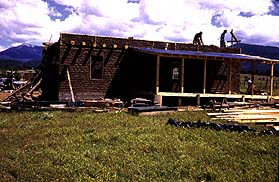 frames,
lumber, etc. Everything was used in this building. We used the old lumber
to frame the foundation and one of the men helping me later even pulled
out and straightened the old nails for reuse: that tells you how rare manufactured
goods used to be (today it's cheaper to by a new handsaw than to have one
sharpened). The trastero (cupboard) in the kitchen came out of the house
and cost an extra $5. At the time I was an Assistant Professor of Sociology
at Colorado State University (Ft.Collins) and intended to use this as a
vacation place. The power lines didn't reach up here in those days and
our water came from the irrigation ditches so it would be an adventure.
I had young kids and spoke a little Spanish so I felt quite well accepted
for someone who didn't go to grade school with them or marry into the family.
frames,
lumber, etc. Everything was used in this building. We used the old lumber
to frame the foundation and one of the men helping me later even pulled
out and straightened the old nails for reuse: that tells you how rare manufactured
goods used to be (today it's cheaper to by a new handsaw than to have one
sharpened). The trastero (cupboard) in the kitchen came out of the house
and cost an extra $5. At the time I was an Assistant Professor of Sociology
at Colorado State University (Ft.Collins) and intended to use this as a
vacation place. The power lines didn't reach up here in those days and
our water came from the irrigation ditches so it would be an adventure.
I had young kids and spoke a little Spanish so I felt quite well accepted
for someone who didn't go to grade school with them or marry into the family.
In the summer of 1965 (I think it was) a friend of mine and I decided to come down from
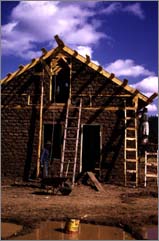
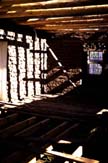 Colorado
and try our hand at traditional building. Neither one of us had much experience,
but I knew everyone around here had built their own houses and all I had
to do was ask to find out something. The first problem was finding someone
reliable to work with us in putting up a building. I asked around town
to find the right kind of help and the going wage ($1.50 per hour). But
when I talked to Gregorio Lopez about working, I was greeted by severe
skepticism, "Well I don't know...", "I'll think about it..."
etc. I didn't think at the time but of course they really didn't know much
about MY reliability. I began to think I wasn't going to get much help
and it made me mad enough to decide I'd do it by myself if I had to. So
Dale and I spent the next few days framing up and pouring the foundation
(that's when I learned you have to add sand to the gravel when you make
concrete - after I had made a pebbly pour). Gregorio Lopez was something
of a perfectionist and when he arrived on Monday he walked around the foundation,
took some measurements, sighted along the walls and said, "I'll start
tomorrow." Apparently we had done a reasonable job.
Colorado
and try our hand at traditional building. Neither one of us had much experience,
but I knew everyone around here had built their own houses and all I had
to do was ask to find out something. The first problem was finding someone
reliable to work with us in putting up a building. I asked around town
to find the right kind of help and the going wage ($1.50 per hour). But
when I talked to Gregorio Lopez about working, I was greeted by severe
skepticism, "Well I don't know...", "I'll think about it..."
etc. I didn't think at the time but of course they really didn't know much
about MY reliability. I began to think I wasn't going to get much help
and it made me mad enough to decide I'd do it by myself if I had to. So
Dale and I spent the next few days framing up and pouring the foundation
(that's when I learned you have to add sand to the gravel when you make
concrete - after I had made a pebbly pour). Gregorio Lopez was something
of a perfectionist and when he arrived on Monday he walked around the foundation,
took some measurements, sighted along the walls and said, "I'll start
tomorrow." Apparently we had done a reasonable job. Dale and I had set up camp by the stack of adobes to get out of the night winds. The first night here, beyond the telephone and electricity lines, with a few twinkling lights off in the distance and a canopy of stars overhead which are now obscured behind a reflecting haze, we were shocked to find our altitude and line of sight to Albuquerque gave us sparkling clear FM classical music! It was a paradise.
Our first structure was four tall posts in the ground to which we attached a tarpaulin for a roof and another at the back, for it was the rainy season in the afternoons and a burning
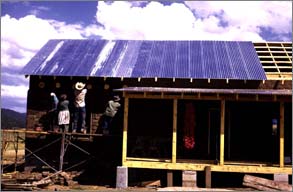 sun
in the mornings cried out for shelter as we bounced between extremes of
temperature which confounded our body thermostats. We placed our trastero
at the rear for an improvised kitchen but as shelter it left much to be
desired. The afternoon rain would blow in from the west and the rain came
in horizontal sheets as the rear tarp, hinged at the top, danced at the
same angle. The storms moved east until they hit the mountains where they
turned around and reattacked from the rear. Some shelter!
sun
in the mornings cried out for shelter as we bounced between extremes of
temperature which confounded our body thermostats. We placed our trastero
at the rear for an improvised kitchen but as shelter it left much to be
desired. The afternoon rain would blow in from the west and the rain came
in horizontal sheets as the rear tarp, hinged at the top, danced at the
same angle. The storms moved east until they hit the mountains where they
turned around and reattacked from the rear. Some shelter! Gregorio brought his uncle Canuto Martinez (a local Penitente who spoke no English) and with Dale Brinker mixing soquete (mud mortar) on the ground and me hauling adobes to the men, we put up the building in about a month. With adobe walls you have to pause every few days to let the mortar set up sufficiently so that the walls don't topple inwards. The regular afternoon rains sweeping across the Rio Grande Valley at two P.M. buffeting us from opposite directions did not speed up the drying process. When it was time to return to Colorado in the fall, Canuto agreed to build the fireplace so it would be ready when we returned at Thanksgiving. And what a surprise greeted us: the wheat straw in the adobe plaster had sprouted, grown about a foot, and then died so that there was this long white hair all over the fireplace. It was creepy!
1978 was a period of ferment. We experienced the oil shock, rampant inflation, political confusion, and I experienced what Gail Sheehy called a "crucible passage". In addition, the place burned and I had to think about rebuilding. I decided to indulge my eccentricities and homestead embedded in scenic beauty and a 90 day growing
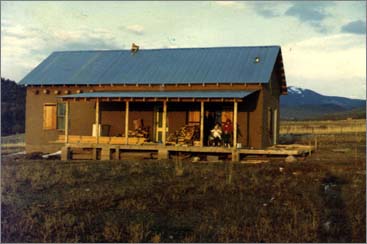 season.
I had reason to believe the traditional hacienda design was practical for
this location and I felt I could use solar design to enhance living conditions
at this altitude. I began planning a layout, read about solar
design, and built a model for future construction. For the first few years
we cooked on the wood stove as there was no electricity or running water.
Without going into all the difficulties, I can say my wife and I worked
like Trojans. A few examples can provide an idea.
season.
I had reason to believe the traditional hacienda design was practical for
this location and I felt I could use solar design to enhance living conditions
at this altitude. I began planning a layout, read about solar
design, and built a model for future construction. For the first few years
we cooked on the wood stove as there was no electricity or running water.
Without going into all the difficulties, I can say my wife and I worked
like Trojans. A few examples can provide an idea. At one point we had an egg farm with 800 chickens and had to haul 40 gallons of water a day for the birds. We bathed by heating water on the stove, then setting a galvanized tub in front of the fireplace to keep warm. At night we put the little stove lids in a paper bag and stuck them under the covers to preheat the bed, otherwise the sheets felt like cold aluminum when you got in. And reading by kerosene lamp offered fumes which encouraged "lights out".
With a single pair of insulated boots in winter one had to be sure they would dry out overnight or you didn't go out the next day, so I built a rack by the heat stove where I could hang my boots upside down to allow heat to toast out moisture. Little acts of planning like that are crucial when living so close to the elements.
Later when the neighbors put their house up for sale they asked us to keep an eye on it for them and let us use their tub for the luxury of a bath. (In the ferocious winter
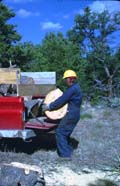 of
1983 the snow was so deep that we used snow shoes to reach their house
and were able to walk across the fences like they weren't there.) We would
use those weekly ablutions as an opportunity to experience a touch of civilization
by going out to dinner in the valley. (But our civilized disguise was ineffective
because all our clothes smelled of wood smoke). However, upon returning
home our deluxe occasional purity was ravaged by the necessity of installing
chains to climb the driveway. The warmer temperatures of the valley meant
the snow under the truck was melting and when I got underneath to put on
chains, the muddy water would drip onto my face and into my clean hair!
In winter we had to cut eight cords of firewood to heat the house, for
unheated adobe walls to reach the 50 degree temperature of a cave they
take two days to heat up. (This eight cords was cut in half when I later
installed solar.) Such were the major and minor inconveniences of homesteading
in the mountains, but it was mostly clean work, without intellectual posturing
and at the end of the day we knew what we had accomplished.
of
1983 the snow was so deep that we used snow shoes to reach their house
and were able to walk across the fences like they weren't there.) We would
use those weekly ablutions as an opportunity to experience a touch of civilization
by going out to dinner in the valley. (But our civilized disguise was ineffective
because all our clothes smelled of wood smoke). However, upon returning
home our deluxe occasional purity was ravaged by the necessity of installing
chains to climb the driveway. The warmer temperatures of the valley meant
the snow under the truck was melting and when I got underneath to put on
chains, the muddy water would drip onto my face and into my clean hair!
In winter we had to cut eight cords of firewood to heat the house, for
unheated adobe walls to reach the 50 degree temperature of a cave they
take two days to heat up. (This eight cords was cut in half when I later
installed solar.) Such were the major and minor inconveniences of homesteading
in the mountains, but it was mostly clean work, without intellectual posturing
and at the end of the day we knew what we had accomplished. And so began the construction of Rancho Arriba...
To get an idea of comfortable proportions for the future buildings of the compound, I traced an outline of the walls in the snow. If it seemed too small I just drew a line a little farther out in the snow, not thinking about how much more material or effort would be required by adding scope. After all, I was used to kerosene lamps and one room which served as kitchen, living room and shop. I would find out.
In 1980, after minor construction of chicken house and green house, I began the serious work. Starting with the most utilitarian requirements, I put up the large shop which could accommodate my vehicles and give me a place to work indoors in the winter. Labor was always a problem as people would often work until they earned what they wanted but wouldn't say anything other than, "See you Monday," and Monday never came. I had some really good help from a man and his two sons from Chihuahua who came back for two years and laid many adobes. And Esteban who also came from Chihuahua returned many times and wrote his name on every plastered wall he could. There were some good and honest men for several years who helped here.
After putting up the shop I decided I'd better see if I had water here before I invested too much in building. My neighbors to the South went 500 feet and never found water, and I knew others who dug repeated wells and didn't hit it. On the other hand, my neighbors to the west have the best well in town so it's hit or miss around here. I got a divining rod
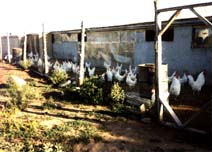 from
Nelson Martinez and witched the stream up from their house, but found it
dropped down the hill before reaching my place. So I was confined to several
small inklings in various sites near the house. I chose a moderately strong
pull by the front door confirmed by two of my three daughters who also
have the touch. At 320 feet we hit it.
from
Nelson Martinez and witched the stream up from their house, but found it
dropped down the hill before reaching my place. So I was confined to several
small inklings in various sites near the house. I chose a moderately strong
pull by the front door confirmed by two of my three daughters who also
have the touch. At 320 feet we hit it. For most of the next ten years construction was my main obsession. I got a home owner electrician's license and wired the house and learned plumbing to put in running water. Around 1983 we opened the bed and breakfast while still living in the original house. The first year there was only an outhouse. (Guests had to be adventurous.) With my passion for building, we had to find some way to use all this space and the B&B seemed like a good way. Inspired by the Jeffersonian model of self sufficiency, I made furniture, light fixtures, worked on my vehicles, butchered meat and smoked bacon, trapped coyotes stalking my animals, and made buckskin clothing . I learned more in the first year than I had in the previous ten. In addition to my archeology, horses, farming and building, it has pretty well kept me out of serious trouble.
These pictures give samples of homesteading activities and all the massive building which has gone on here over the last thirty years. The personnel has changed, my kids are long gone, Rosalinda brought her kids, sister and niece, others came and went; but the building persisted. Having gone from using horses to pack hay up my road through the snow, reading by the soft light of kerosene and melting snow for water in winter, to sitting before this computer writing this account in the relative comfort of hot water heat, I feel I have traversed the whole industrial revolution in a scant twenty years.
Back to History Page
© 1997 Rancho Arriba Bed and Breakfast